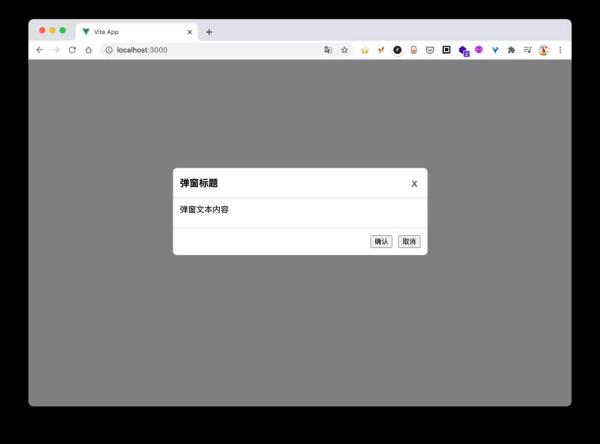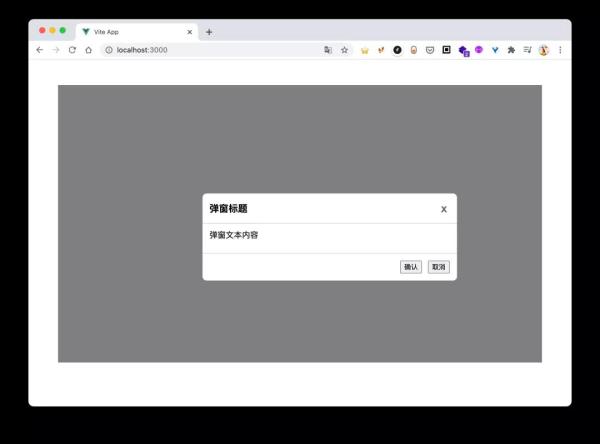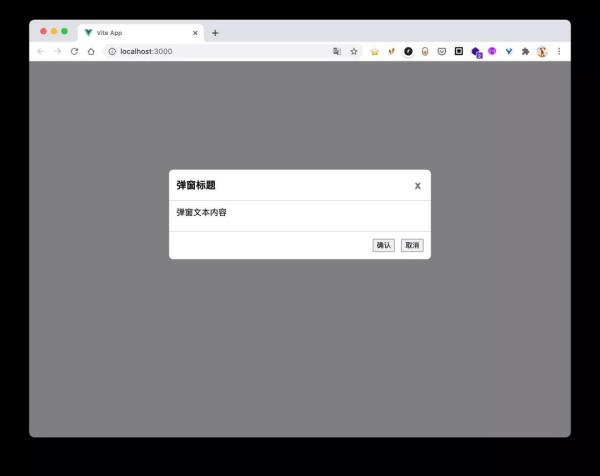这篇文章将为大家详细讲解有关Vue3中Teleport 组件的原理是什么,文章内容质量较高,因此小编分享给大家做个参考,希望大家阅读完这篇文章后对相关知识有一定的了解。
使用场景
业务开发的过程中,我们经常会封装一些常用的组件,例如 Modal 组件。相信大家在使用 Modal 组件的过程中,经常会遇到一个问题,那就是 Modal 的定位问题。
话不多说,我们先写一个简单的 Modal 组件。
<!-- Modal.vue --> <style lang="scss"> .modal { &__mask { position: fixed; top: 0; left: 0; width: 100vw; height: 100vh; background: rgba(0, 0, 0, 0.5); } &__main { margin: 0 auto; margin-bottom: 5%; margin-top: 20%; width: 500px; background: #fff; border-radius: 8px; } /* 省略部分样式 */ } </style> <template> <div class="modal__mask"> <div class="modal__main"> <div class="modal__header"> <h4 class="modal__title">弹窗标题</h4> <span class="modal__close">x</span> </div> <div class="modal__content"> 弹窗文本内容 </div> <div class="modal__footer"> <button>取消</button> <button>确认</button> </div> </div> </div> </template> <script> export default { setup() { return {}; }, }; </script>然后我们在页面中引入 Modal 组件。
<!-- App.vue --> <style lang="scss"> .container { height: 80vh; margin: 50px; overflow: hidden; } </style> <template> <div class="container"> <Modal /> </div> </template> <script> export default { components: { Modal, }, setup() { return {}; } }; </script>
Modal
如上图所示, div.container 下弹窗组件正常展示。使用 fixed 进行布局的元素,在一般情况下会相对于屏幕视窗来进行定位,但是如果父元素的 transform, perspective 或 filter 属性不为 none 时,fixed 元素就会相对于父元素来进行定位。
我们只需要把 .container 类的 transform 稍作修改,弹窗组件的定位就会错乱。
<style lang="scss"> .container { height: 80vh; margin: 50px; overflow: hidden; transform: translateZ(0); } </style>
Modal
这个时候,使用 Teleport 组件就能解决这个问题了。
“Teleport 提供了一种干净的方法,允许我们控制在 DOM 中哪个父节点下呈现 HTML,而不必求助于全局状态或将其拆分为两个组件。-- Vue 官方文档
我们只需要将弹窗内容放入 Teleport 内,并设置 to 属性为 body,表示弹窗组件每次渲染都会做为 body 的子级,这样之前的问题就能得到解决。
<template> <teleport to="body"> <div class="modal__mask"> <div class="modal__main"> ... </div> </div> </teleport> </template>
可以在 https://codesandbox.io/embed/vue-modal-h6g8y 查看代码。

使用 Teleport 的 Modal
源码解析
我们可以先写一个简单的模板,然后看看 Teleport 组件经过模板编译后,生成的代码。
Vue.createApp({ template: ` <Teleport to="body"> <div> teleport to body </div> </Teleport> ` })
模板编译后的代码
简化后代码:
function render(_ctx, _cache) { with (_ctx) { const { createVNode, openBlock, createBlock, Teleport } = Vue return (openBlock(), createBlock(Teleport, { to: "body" }, [ createVNode("div", null, " teleport to body ", -1 /* HOISTED */) ])) } }可以看到 Teleport 组件通过 createBlock 进行创建。
// packages/runtime-core/src/renderer.ts export function createBlock( type, props, children, patchFlag ) { const vnode = createVNode( type, props, children, patchFlag ) // ... 省略部分逻辑 return vnode } export function createVNode( type, props, children, patchFlag ) { // class & style normalization. if (props) { // ... } // encode the vnode type information into a bitmap const shapeFlag = isString(type) ? ShapeFlags.ELEMENT : __FEATURE_SUSPENSE__ && isSuspense(type) ? ShapeFlags.SUSPENSE : isTeleport(type) ? ShapeFlags.TELEPORT : isObject(type) ? ShapeFlags.STATEFUL_COMPONENT : isFunction(type) ? ShapeFlags.FUNCTIONAL_COMPONENT : 0 const vnode: VNode = { type, props, shapeFlag, patchFlag, key: props && normalizeKey(props), ref: props && normalizeRef(props), } return vnode } // packages/runtime-core/src/components/Teleport.ts export const isTeleport = type => type.__isTeleport export const Teleport = { __isTeleport: true, process() {} }传入 createBlock 的第一个参数为 Teleport,最后得到的 vnode 中会有一个 shapeFlag 属性,该属性用来表示 vnode 的类型。isTeleport(type) 得到的结果为 true,所以 shapeFlag 属性最后的值为 ShapeFlags.TELEPORT(1 << 6)。
// packages/shared/src/shapeFlags.ts export const enum ShapeFlags { ELEMENT = 1, FUNCTIONAL_COMPONENT = 1 << 1, STATEFUL_COMPONENT = 1 << 2, TEXT_CHILDREN = 1 << 3, ARRAY_CHILDREN = 1 << 4, SLOTS_CHILDREN = 1 << 5, TELEPORT = 1 << 6, SUSPENSE = 1 << 7, COMPONENT_SHOULD_KEEP_ALIVE = 1 << 8, COMPONENT_KEPT_ALIVE = 1 << 9 }在组件的 render 节点,会依据 type 和 shapeFlag 走不同的逻辑。
// packages/runtime-core/src/renderer.ts const render = (vnode, container) => { if (vnode == null) { // 当前组件为空,则将组件销毁 if (container._vnode) { unmount(container._vnode, null, null, true) } } else { // 新建或者更新组件 // container._vnode 是之前已创建组件的缓存 patch(container._vnode || null, vnode, container) } container._vnode = vnode } // patch 是表示补丁,用于 vnode 的创建、更新、销毁 const patch = (n1, n2, container) => { // 如果新旧节点的类型不一致,则将旧节点销毁 if (n1 && !isSameVNodeType(n1, n2)) { unmount(n1) } const { type, ref, shapeFlag } = n2 switch (type) { case Text: // 处理文本 break case Comment: // 处理注释 break // case ... default: if (shapeFlag & ShapeFlags.ELEMENT) { // 处理 DOM 元素 } else if (shapeFlag & ShapeFlags.COMPONENT) { // 处理自定义组件 } else if (shapeFlag & ShapeFlags.TELEPORT) { // 处理 Teleport 组件 // 调用 Teleport.process 方法 type.process(n1, n2, container...); } // else if ... } }可以看到,在处理 Teleport 时,最后会调用 Teleport.process 方法,Vue3 中很多地方都是通过 process 的方式来处理 vnode 相关逻辑的,下面我们重点看看 Teleport.process 方法做了些什么。
// packages/runtime-core/src/components/Teleport.ts const isTeleportDisabled = props => props.disabled export const Teleport = { __isTeleport: true, process(n1, n2, container) { const disabled = isTeleportDisabled(n2.props) const { shapeFlag, children } = n2 if (n1 == null) { const target = (n2.target = querySelector(n2.prop.to)) const mount = (container) => { // compiler and vnode children normalization. if (shapeFlag & ShapeFlags.ARRAY_CHILDREN) { mountChildren(children, container) } } if (disabled) { // 开关关闭,挂载到原来的位置 mount(container) } else if (target) { // 将子节点,挂载到属性 `to` 对应的节点上 mount(target) } } else { // n1不存在,更新节点即可 } } }其实原理很简单,就是将 Teleport 的 children 挂载到属性 to 对应的 DOM 元素中。为了方便理解,这里只是展示了源码的九牛一毛,省略了很多其他的操作。
关于Vue3中Teleport 组件的原理是什么就分享到这里了,希望以上内容可以对大家有一定的帮助,可以学到更多知识。如果觉得文章不错,可以把它分享出去让更多的人看到。
免责声明:本站发布的内容(图片、视频和文字)以原创、转载和分享为主,文章观点不代表本网站立场,如果涉及侵权请联系站长邮箱:is@yisu.com进行举报,并提供相关证据,一经查实,将立刻删除涉嫌侵权内容。